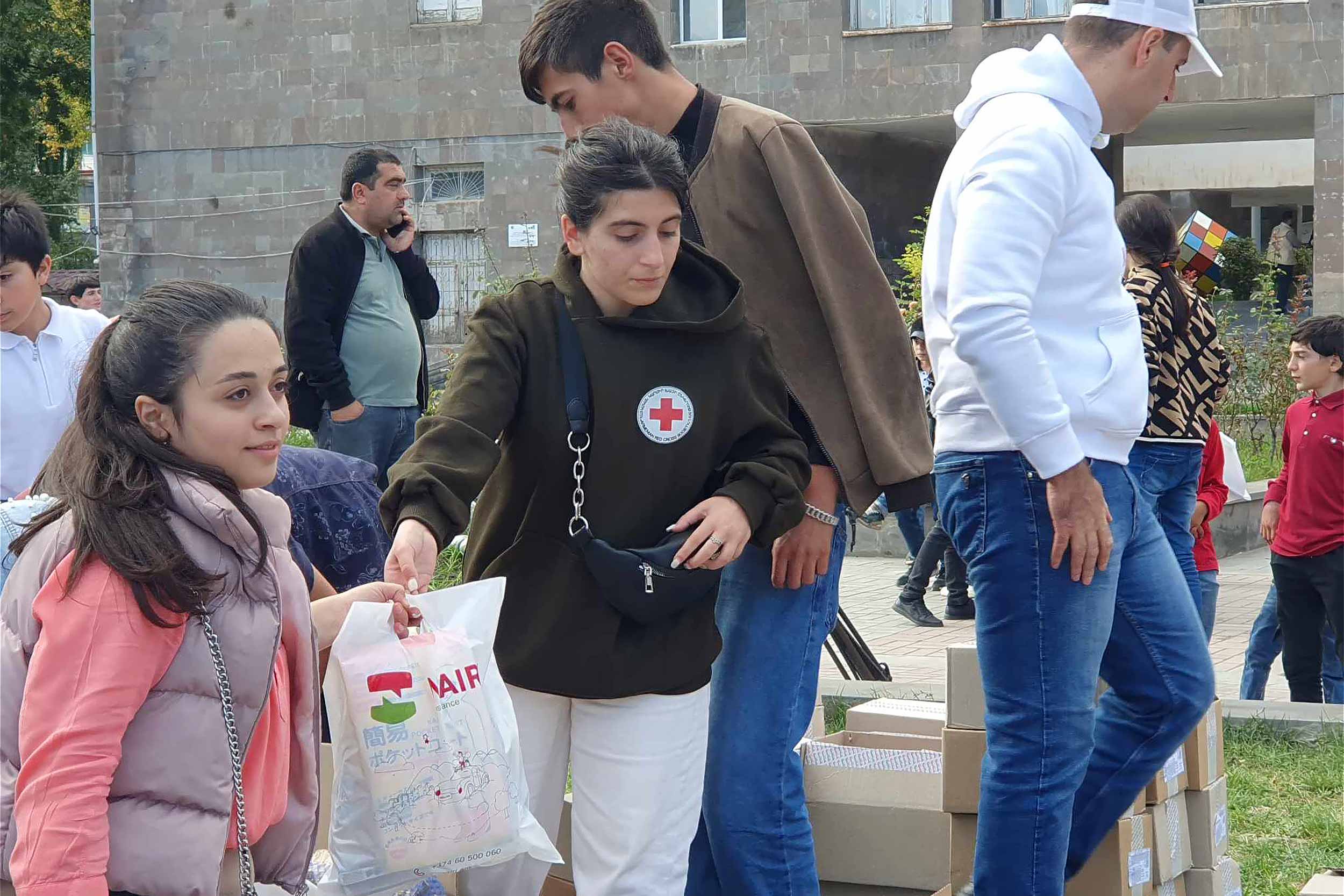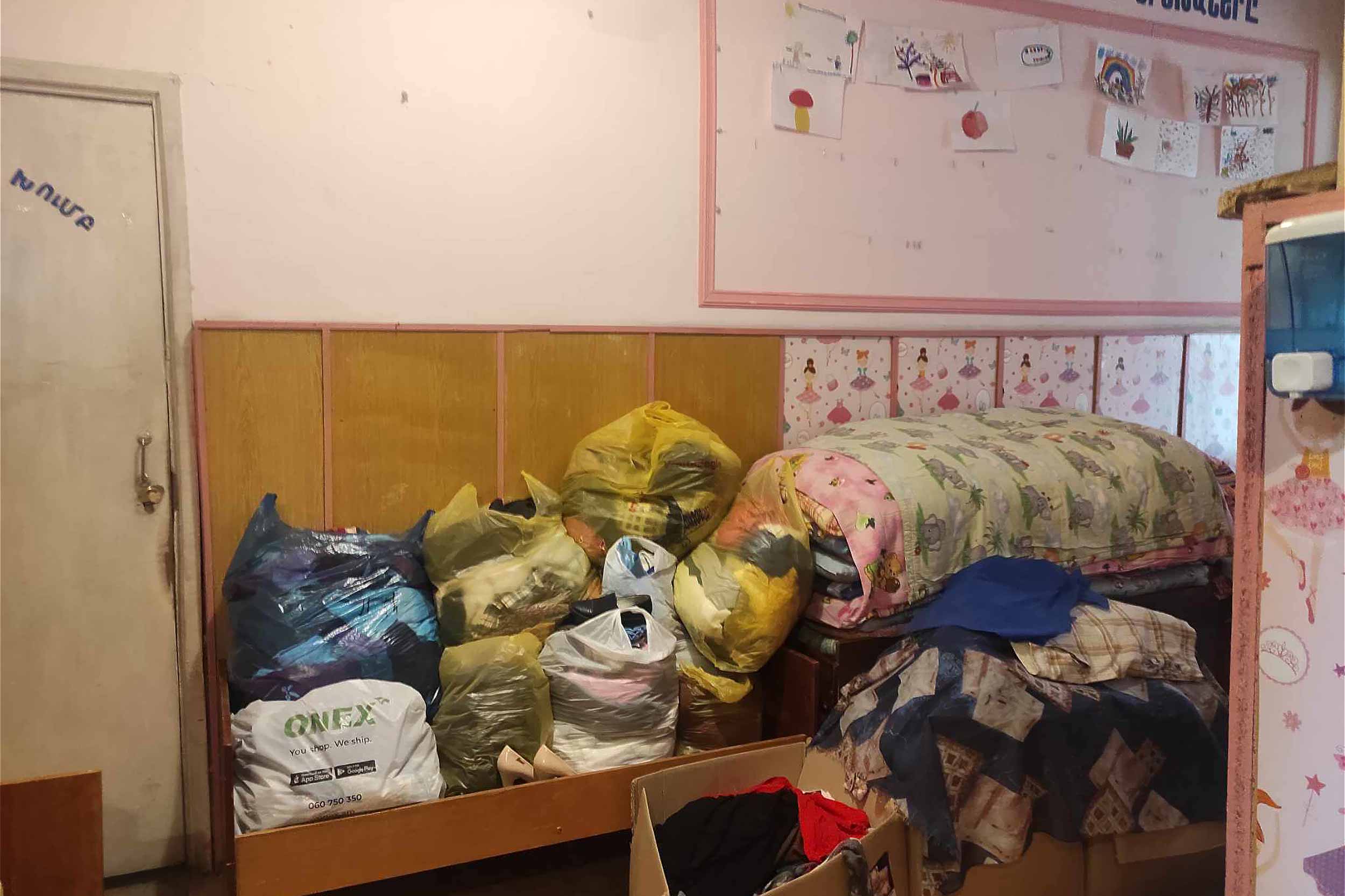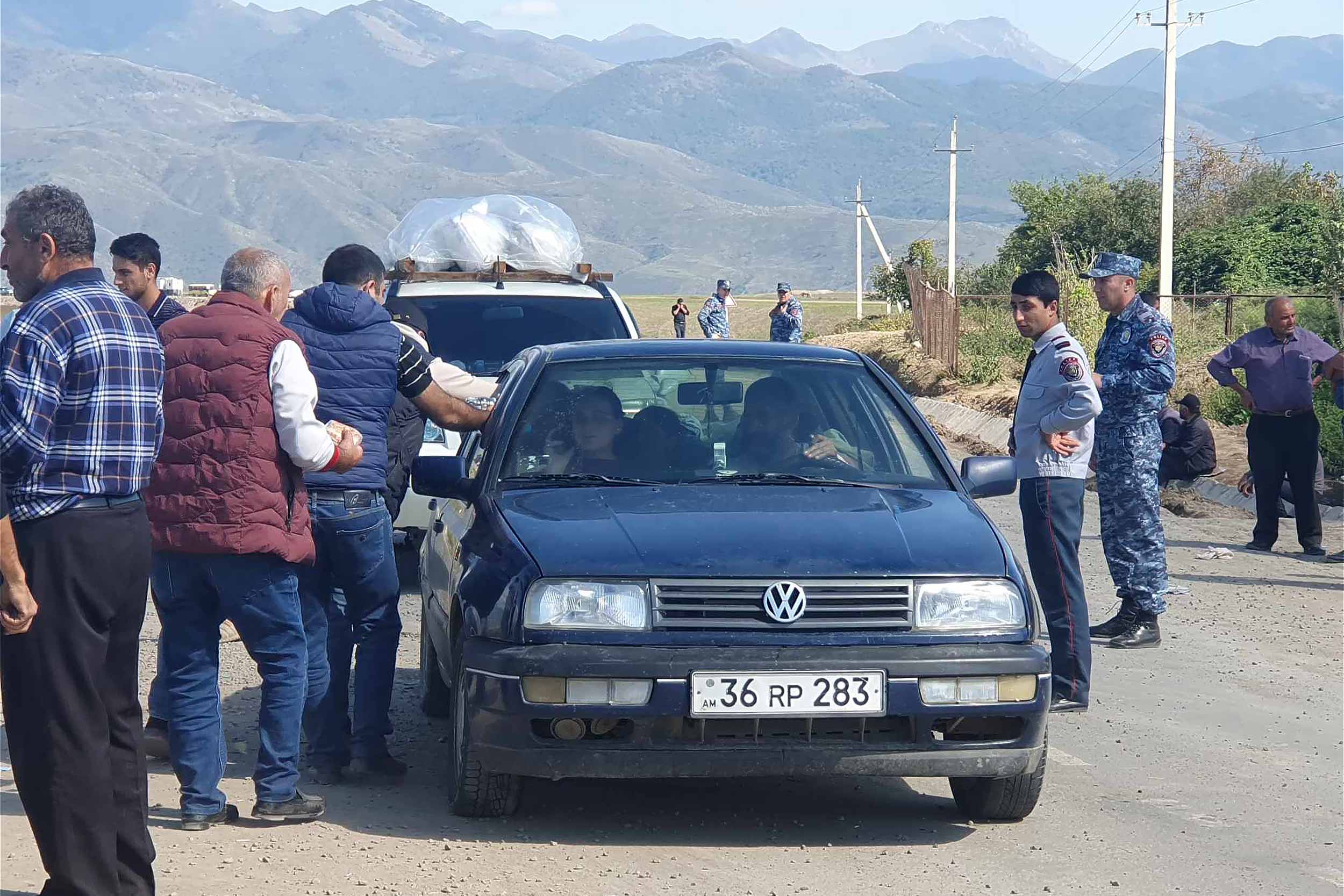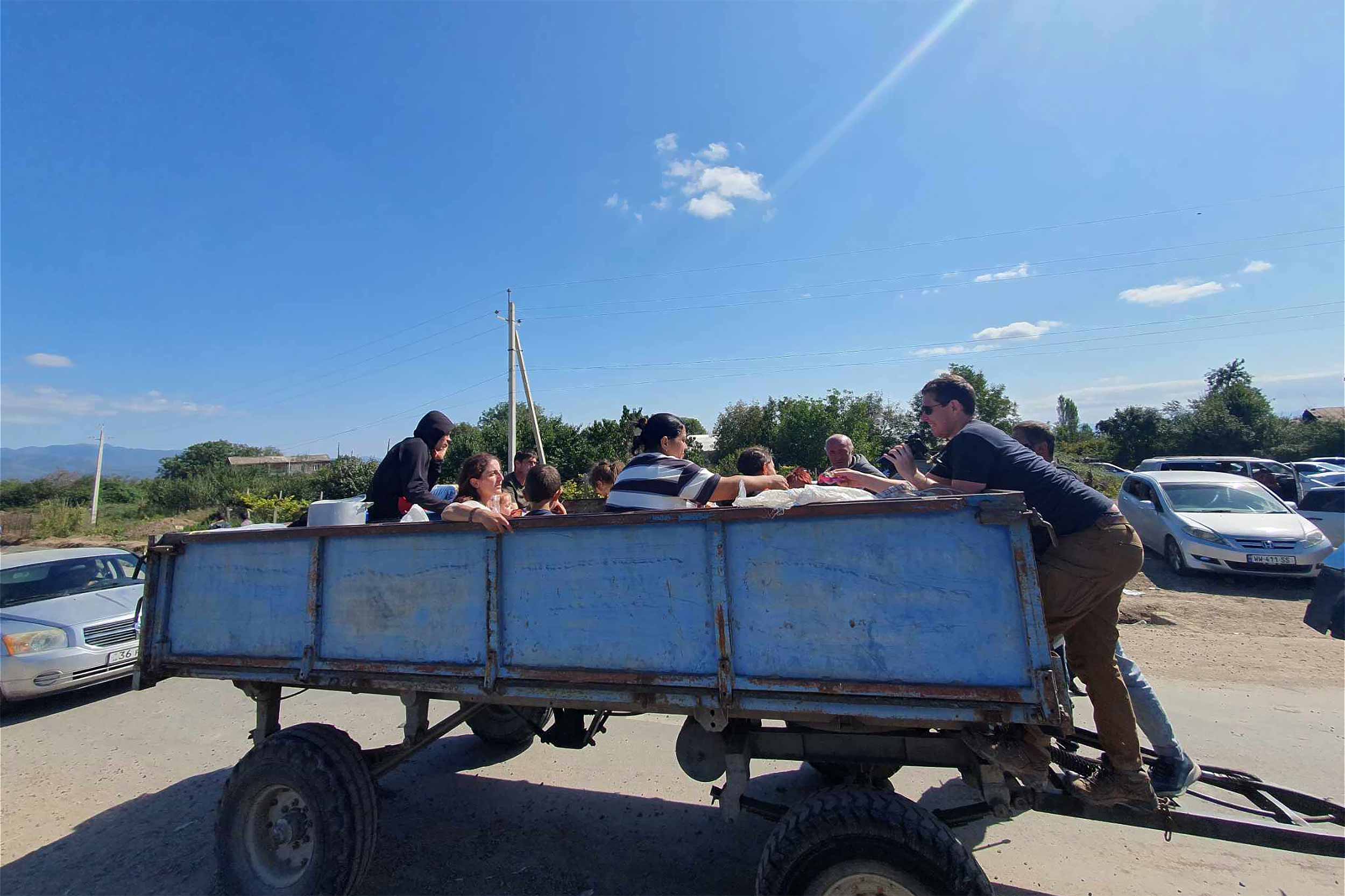Nagorny Karabakh: “My Children Don’t Know What Peace Is”
Some 100,000 civilians have fled the disputed region, facing an uncertain future and an unclear legal status.
Serdak Hakobyan arrived in Armenia’s southern city of Goris on a tractor pulling a trailer carrying his and his brother’s family - 11 people in total.
“As soon as we learned that the [Lachin] road was opened, we collected the essential items and left Artsakh (the Armenian name for Nagorny Karabakh),” the 47-year-old farmer told IWPR. “It is impossible to live there under blockade, when there is nothing to eat, then under constant threat of destruction. Now our children will not starve at least. We will have bread, but we will no longer have our homeland.”
Hakobyan, from the Karabakh village of Astkhashen, wants to settle in rural Armenia, but “not along the border with Azerbaijan”.
“I have seen four wars in my life, in the early 1990s, then in 2016, in 2020 and again [this] September. My children don’t know what peace is; they deserve to live in peaceful conditions,” he continued, adding that he expects “adequate support” from the Armenian government.
Hakobyan is one of over 100,000 Armenians who have fled Karabakh and poured into the republic of Armenia in a matter of a few days.
Unresolved for three decades, the conflict over the Armenian-populated region of Nagorny Karabakh, which lies within Azerbaijan’s international borders, was brought to a conclusion by the 24-hour military operation the Azerbaijani forces launched on September 19. Baku regained control over the breakaway region, triggering a mass exodus of the civilian population.
Baku has long been clear about the choice for Karabakh Armenians; either stay and accept Azerbaijan’s rule, or leave. Most of the estimated 120,000 residents chose the latter and have left a land where Armenians have lived for centuries and regard as their ancestral home.

As of October 3, 100,617 had left the region and vehicles continued to cross Hakari bridge, where the Azerbaijan police have a checkpoint, heading to Gori.
Authorities stated that the region was now virtually empty of Armenian residents and that the once lively Stepanakert, the regional centre Azerbaijanis call Khankendi, had become a ghost town.
People arrived via the Lachin corridor, the serpentine mountain road which was the region’s critical lifeline. The blockade imposed on the road since December 12, 2022 – first by Azerbaijani so-called eco-activists and then by the authorities - resulted in severe shortages of essential supplies, including food, medicines and fuel.
As the opening of the road was announced on September 24, Karabakh Armenians started gathering their belongings and loading them onto all available vehicles. People endured up to 30 hours to cover the 90 kilometres separating Stepanakert and Goris, a journey that would usually take two hours.
The exact number of Armenians who remain in the region is unknown; only Russian peacekeepers and Azerbaijani forces are visible. On October 2 the Karabakh Information Headquarters reported that a team of officials remained in Stepanakert to complete the search and rescue efforts for missing persons and for the identification procedure of those killed during the fighting.
These include de facto president Samvel Shahramanyan who on September 28 signed a decree dissolving the army and all state institutions announcing “the Republic of Artsakh will cease to exist” from January 1, 2024.

"WE WERE HUNGRY, FEARED FOR OUR LIVES”
Laura Stepanyan left Stepanakert on September 25 with her family of five.
“We were on the road for almost two days, we were hungry and feared for our lives. There were moments when we were overwhelmed with doubts that we were unlikely to reach Armenia,” she told IWPR as she queued at the refugee reception centre.
The 42-year-old worked as a cleaner: with no idea what the future entails she hopes that the Armenian government will assist her family, “at least at the beginning” until they get back on their feet.
The scale of the arrivals caught the authorities off guard. Masis, a town of about 20,000 people in western Armenia, has received nearly 11,000 refugees.
“We deal with everything all by ourselves,” Norayr Hakobyan, the deputy mayor, told IWPR. “Local residents also help in any way they can – these are household goods, kitchen furniture, dishes, beds. The state has not yet allocated any funds or subsidies to host and accommodate the refugees.”
Official data indicated that 54 per cent of the refugees who have arrived, some 54,000 people, have accepted the accommodation offered by the government and local authorities.
“We were accommodated in an old unused kindergarten in Masis. There are no basic conditions here. We need a proper place to live,” 63-year-old Siranush told IWPR.
Some refugees, however, are already considering moving on.

“It’s likely that our family will go to Krasnodar [in south-western Russia] to join our relatives,” one man, who asked to remain anonymous, told IWPR.
The Armenian government has asked the EU for medical supplies and temporary shelters to cope with the enormous influx. Thousands of officials and volunteers are at the humanitarian centre set up in Goris to offer food, medical assistance, rest and information about housing and employment.
Tigran Khachatryan, Armenia’s first deputy prime minister, who was appointed as coordinator of humanitarian assistance, said that the government would give each refugee a one-time payment of 100,000 drams (250 US dollars) regardless of their age. In addition, starting from October 1, each household will receive a monthly allowance of 50,000 drams (120 dollars) to cover rent and utility bills for a period of one year.
The government also pledges to resolve the issues related to re-registration of pensions and employment of Karabakh teachers, military personnel and doctors. Additional social support will be provided for teachers.
These issues are less challenging; Yerevan has funded the de facto state budget of the unrecognised republic since the end of the First Karabakh War in the mid-1990s, under the guise of an interstate loan. Since the Second Karabakh war of late 2020, the Armenian government has allocated about 400 million dollars annually to support the region’s economy.

REFUGEE PROTECTION
Nonetheless, the Karabakh Armenians’ legal status pose a serious challenge. Since the region lies inside Azerbaijan, those who arrived in the Republic of Armenia have crossed an international border, hence are refugees, not internally displaced persons (IDPs).
At the same time, the vast majority hold Armenian passports, which may affect the process of obtaining refugee status with subsequent international protectio
“They must be granted refugee status as Armenian passports are not an obstacle,” said Artur Sakunts, an Armenian human rights activist who leads the Helsinki Citizens' Assembly in the city of Vanadzor. “People [in Karabakh] were issued them so that they could travel. With these passports they did not participate in the social and political life of Armenia and did not vote in elections.”
The government has not yet made a final decision on this issue. The migration service of the Ministry of Internal Affairs did not respond to IWPR’s request for comment.
This publication was prepared under the "Amplify, Verify, Engage (AVE) Project" implemented with the financial support of the Ministry of Foreign Affairs, Norway.
